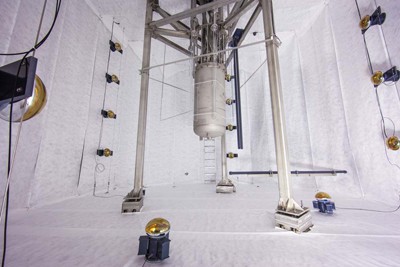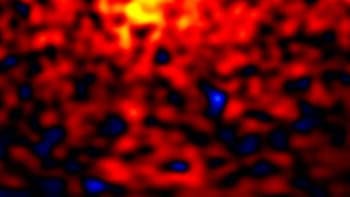
The Large Underground Xenon (LUX) dark-matter detector at the Sanford Underground Research Facility in the US has failed to find any evidence for dark matter in the first three months of its operation. One of the world’s most sensitive dark-matter detectors, LUX has managed to put more stringent limits on what dark matter could be. In particular, the preliminary results suggest that previous hints of low-mass dark-matter particles reported by some other experiments might not be credible.
Dark matter is the name given to the substance thought to account for about 80% of matter in the universe. Its existence is inferred from a range of astrophysical measurements that suggest processes such as galaxy formation and dynamics are influenced by the gravitational forces exerted by dark matter. However, because dark matter does not appear to interact strongly with light and other electromagnetic radiation, astronomers have not been able to observe it directly.
Dark matter should pervade our galaxy and therefore it should be streaming constantly through Earth. As a result, physicists have built a number of detectors that look for the tiny interactions that could occur between dark matter and normal matter. While most detectors have not seen any such interactions, others have seen tantalizing hints of dark-matter particles.
Looking for WIMPs
Located 1500 m under the Black Hills in South Dakota to shield its sensitive detectors from cosmic rays and other background radiation, LUX is the latest such experiment to report results. The detector comprises a 2-m-tall titanium tank filled with 350 kg of liquid xenon that is cooled to –108 °C.
LUX is designed to detect hypothetical dark-matter particles called WIMPs – weakly interacting massive particles – which are expected to collide occasionally with xenon atoms in the tank. If this happens, the recoiling atom will create light and some free electrons. The electrons are accelerated upwards by an electric field, creating more light when they reach a thin layer of xenon gas at the top of the tank. Extremely sensitive light detectors collect the light signals at the collision point and the top of the tank and the energy of the interaction can be calculated from the intensity of the light signals. Detecting two signals from each event makes it easier to discriminate against light created by background radiation.
What dark matter is not
After analysing three months of data taken by LUX, physicists found no evidence for dark-matter collisions. However, because the experiment is the most sensitive yet to a range of WIMP masses, LUX has provided important new information about what dark matter is not. In particular, LUX is more than 20 times more sensitive than previous experiments when it comes to detecting low-mass WIMPs – those with masses of about 5–10 GeV/c2.
Earlier this year, the US-based CDMS dark-matter experiment – located deep underground in the Soudan Mine in northern Minnesota – reported the detection of three WIMPs with masses of about 8.6 GeV/c2. While this mass is much lower than most conventional theories predict, it seems to agree with somewhat weaker observations in several other experiments. The CDMS detection has a statistical significance of about 3σ: well below the gold standard of 5σ, which is considered a discovery in particle physics. As a result some physicists doubt the CDMS result, while others have tried to explain it by developing new theories of WIMPs.
Expected 1600 events
However, the CDMS WIMPs should have produced more than 1600 events in LUX. No such signals were seen, making it much less likely that low-mass WIMPs exist.
“Those ‘hints’ – which were at best controversial – motivated several theories to explain them, which in turn can lend undue credence to those results,” says Henrique Araújo who leads the LUX team at Imperial College London. “But LUX is by far the most sensitive instrument in this hunt, and our very clean data contradict that interpretation emphatically: there may well be other light WIMPs out there, but we are drawing a line under those existing claims.”
LUX is expected to run for two more years and the experiment’s co-spokesperson Dan McKinsey of Yale University is confident that it will continue to make an impact: “This is only the beginning for LUX,” he says. “Now that we understand the instrument and its backgrounds, we will continue to take data, testing for more and more elusive candidates for dark matter.”
Physicists working on LUX are already planning their next experiment at Sanford called LUX-ZEPLIN. It will involve about 20 times more liquid xenon than currently used by LUX and will be about 100 times more sensitive.
A preprint describing the results is available on arXiv.
- Physics World‘s Matin Durrani visited the ZEPLIN-III dark-matter detector in the Boulby Underground Laboratory in Cleveland on the north-east coast of England. You can watch his exploits in this video.



